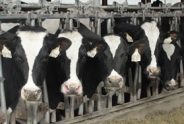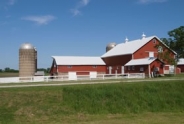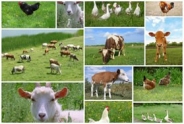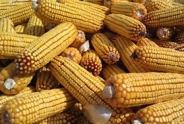Sneaky Pasture Weeds - Sedges and Rushes
Amy Barkley, Team Leader & Livestock Specialist
Southwest New York Dairy, Livestock and Field Crops Program
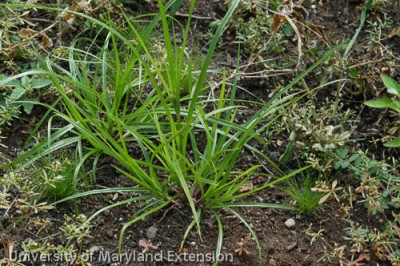
Sneaky Pasture Weeds - Sedges and Rushes
by Kitty O'Neil and Mike Hunter, Regional Field Crops and Soils Specialists
We've discussed pasture grasses, legumes, pasture weeds and management ideas for pasture improvement on these pages many times before. All good topics. When you call to mind pasture weeds though, I'd bet you picture milkweed, goldenrod, a couple different types of thistles and maybe bedstraw. These are pesky and important weeds in many pastures, but there are other, sneakier weeds that may escape your attention. These sly and mischievous weeds require closer inspection and a bit more scrutiny to figure out.
Ideally, pastures are dense, perennial sods consisting of mixtures of high-yielding, palatable grasses and legumes. In reality, most pastures do not quite match this perfect ideal. Weeds are normally present in some number, ranging from insignificant to seriously problematic, depending on management and history. Weed density within a pasture can change over time, and can vary from one area to another within a pasture. You may notice, in your own pastures or hay fields, that weeds are often not distributed uniformly, but rather that some plant species are concentrated on knolls, along the woods, in wet spots, or in high traffic areas.
Let's turn our attention to some particularly sneaky weeds that are often, but not always, found in lower, wetter areas of the pasture - the sedges and rushes. I'm referring to them as 'sneaky' because they're a bit harder to spot in the pasture. They look a lot like grasses to an amateur observer, but that is about as far as the similarities extend. As a group, grasses consist of a jointed stem with a few tillers, long and slender leaves with parallel veins. They range in height from turf to giant bamboo. Grasses may be annual or perennial but all have their growing points near the soil surface, so they can survive repeated mowing or grazing. Grasses reproduce via seed or underground structures. Most of the hay and pasture grass species (bluegrass, orchardgrass, timothy, fescues, reed canarygrass, etc.) are quite palatable and produce moderate to high yields.
Sedge and rush species also have long slender leaves but occupy completely different branches on the evolutionary tree of life than grasses. Sedges and rushes are perennials that livestock typically avoid, finding them unpalatable. There are well over 1000 different sedge species, but the most common sedge found in Northeast pastures and hayfields is Yellow Nutsedge. Yellow nutsedge is noticeable for its pale green color, spiky flowers and underground tubers, but its most distinctive feature is its stem. If you compare the lower stems of sedges and grasses, you'll discover that sedges typically have triangular stems without nodes while grasses have round or flattened stems with nodes. This key difference is the reason for the memorable phrase "sedges have edges, but grasses have knees." Sedges reproduce by underground tubers and rhizomes.
Rushes are short plants that resemble grasses and sedges and are also found in lower, wetter areas of a pasture or hayfield, although rushes may grow in drier or compacted areas too. The unique feature of rushes is their 3-petal, lily-like flowers. In fact, botanists refer to rushes as "lilies turned to grass" to help them remember their distinctive flowers. Rushes reproduce by vegetative rhizomes or by seed. The tough, wiry, round stems of rushes are also avoided by livestock who generally do not find them palatable. In the Northeast, the most common of the rushes is Slender Rush.
Nutsedge and rushes might be most noticeable as animals are finished with a pasture or paddock. The livestock will have eaten grasses and other appealing plants, leaving behind patches of Yellow Nutsedge and Slender Rush. It is disappointing to see large, uneaten areas of low-yielding, unpalatable pasture, but biological features of rush and sedge make them difficult to control. Their underground reproductive structures make mowing or clipping ineffective as a means for removal, but this strategy can slow their spread, if it is timed before flowering. Herbicide options for these two weeds are limited, but Permit and Yukon have recently had hay and pasture applications added to their labels. They may be used on yellow nutsedge in grass pastures with no grazing restriction for lactating or non-lactating animals. If the field is not too wet for machinery, suitable grasses or legumes can be overseeded with a no-till drill or, as a more drastic measure, the sod may be killed and soil can be tilled for replanting of appropriate grasses and legumes. Often though, the sedges and rushes occupy areas that may be difficult to access with tractor equipment. In this case, the field could be tiled for better drainage if that option is economically advantageous. Legume species such as red or white clover can be frost-seeded in the spring to try and introduce more desirable species, but the rush and sedge species will likely persist. Sedge and rush weeds take a keen eye to notice, but their impact can be just as important as thistles or milkweed or goldenrod in a pasture or hayfield. Their presence reduces overall productivity of the field and presents a challenge to the farm manager.
Additional resources:
1. Uva, Neal and DiTomaso, Weeds of the Northeast, Ithaca, NY: Cornell University Press, 1997.
2. Kersbergen, R. 2004. Bulletin #2491, This Old Hayfield: A Fact Sheet on Hayfield Renovation. U Maine Extension.
3. Specification Guide Sheet For Pasture and Hay Planting (512), Vermont NRCS http://www.nrcs.usda.gov/Internet/FSE_DOCUMENTS/nrcs144p2_016364.pdf.
4. Yukon (http://www.gowanco.com/products/yukon.aspx) and Permit (http://www.gowanco.com/products/permit.aspx) herbicides, Gowan Company.
For more information about pasture management, you can reach out to Amy Barkley, Livestock and Beginning Farm Specialist at amb544@cornell.edu or (716) 640-0844. If you would like more information on weed management, contact Josh Putman, Field Crops and Forage Specialist, at jap473@cornell.edu or (716) 490-5572.
Sneaky Pasture Weeds - Sedges and Rushes (pdf; 290KB)
Upcoming Events
Crops, Cows & Critters - Southwest New York Dairy, Livestock & Field Crops Newsletter Sponsorship
December 19, 2025
Our two forms of publications feature research-based and timely information from our four specialists, listed to the right, along with local event notifications and Cornell University outreach. This information is provided to participants who range from dairy, livestock, and field crops producers to agricultural suppliers and consultants.
Weekly Email Update: Shared with 625+ households who have signed up with our program.
Monthly Paper Mailer: To reach our stakeholders and farmers who lack internet access, we send out a monthly mailer where your company's logo and contact information would be featured with a mailing list of 330+ households.
If you sponsor our weekly and monthly publications you reach approximately 955 households.
Visit our website to view our newsletters!
2025 Cornell Food Beverage & Animal Feed Manufacturer Survey
December 19, 2025
Industry and Educational Advocates for New York State's Food, Beverage, and Animal Feed Manufacturing industries:
As you know, NYS has a diverse food and beverage manufacturing industry, in both the types of industries that exist and the wide distribution of firms by scale. Many manufacturing firms have strong backward linkages to agricultural production sectors in the state that support both farm-level and downstream food industry firms and consumers. In collaboration with the New York State Department of Agriculture and Markets, a team from Cornell University's Charles H. Dyson School of Applied Economics and Management has recently rolled out the 2025 New York State Food, Beverage, and Animal Feed Manufacturer Survey. The industry will benefit from an updated assessment of the industry that informs private and public investments and opportunities to support firm growth and improved profitability.
Cornell Organic Field Crops & Dairy Conference
March 6, 2026
Waterloo, NY
Farmers, researchers, educators, and agricultural service providers from across the Northeast are invited to the 2026 Cornell Organic Field Crops & Dairy Conference, held Friday, March 6, 2026, from 8:00 a.m. to 4:30 p.m. at the Lux Hotel & Conference Center in Waterloo, N.Y.
Co-hosted by New York Soil Health and Cornell CALS, the annual conference brings together leaders in organic grain, dairy, and livestock systems to share practical tools, new research, and farmer-tested strategies to support resilient and profitable organic production.
Announcements
No announcements at this time.


